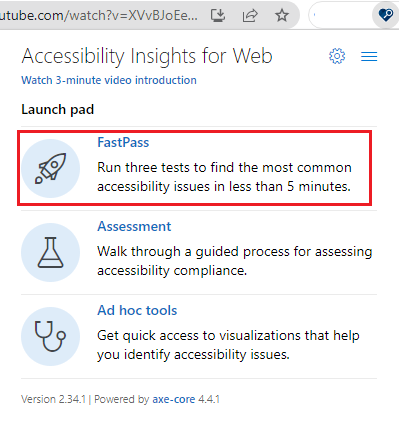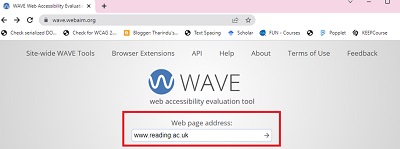Evaluating webpage accessibility
Web Accessibility refers to creating web content that can be used by as many people as possible including people with disabilities or impairments.Under The Public Sector Bodies (Websites and Mobile Applications) (No. 2) Accessibility Regulations the University is required to make the web content accessible to WCAG 2.2 AA standard.
Accessibility Checklist
UK Government's Accessibility Checklist is comprehensive and should be consulted to check compliance with WCAG 2.1 AA standard. You must be able to answer Yes or Not Applicable to all of the questions in the checklist to meet WCAG 2.1 to level AA standard. Note this checklist is for WCAG 2.1AA.
The University of Reading guide Creating accessible online content is available for you to consult.
Web Accessibility Testing
Keyboard Test
The website and its content should be fully accessible by keyboard navigation. Using the tab key navigate to all the options, menus, buttons and other functionality on the page. This test is an important part of making your website accessible to the required standard.
If there is page content that update real time (for example, Twitter feeds) there should be a way for a user to skip out of it. You should also be able to see where you are (focus) on the page as you tab through it.
Web Tools for Accessibility Evaluation
There are various free and paid-for tools to test accessibility of websites. Listed here are some free tools that can be used.
Accessibility Insights for Web

Accessibility Insights for Web is an extension for Chrome and Edge to evaluate accessibility of web apps and sites. This tool provides automated testing as well as supports guided manual testing. An introduction to Accessibility Insights for Web provides step by step guide to using the tool.
On a chrome browser, visit the Chrome web store and search for Accessibility Insights for Web extension and add it to your browser extensions. Once added it will be visible on to the right side of the address bar in the extensions menu. To test a webpage, load the page on Chrome browser and click on the Accessibility Insights for Web extension. This will open a menu with the option to use Fast Pass or Assessment.

Fast Pass – this is the automated testing supported by the Accessibility Insights for Web. The tool automatically checks for compliance with approximately 50 accessibility requirements.
Manual Tests – the tool provides step-by-step instructions to conduct the manual tests and many tests are assisted with a visual helper.
The results of the test you have conducted can be exported as an HTML file as an audit trail by selecting the Export result option.
WAVE Web Accessibility Evaluation Tool
WAVE tool is available as a WAVE browser extensions for Chrome, Firefox, and Edge.

Alternatively you can enter the URL to test on the online WAVE tool. An introduction to WAVE video shows how to evaluate a webpage with the tool and how to interpret its results.
axe DevTools
axe DevTools is a another accessibility evaluation tool. This allows the basic tests to be done with a free to use axe DevTools Chrome extension. However, to save your results or to conduct in depth evaluation you must have a paid-for account. This is the tool used by the Government Digital Services to test accessibility compliance.
Compliance
If you create or edit content on any of University of Reading webpages, please use the resources available to ensure the pages are WCAG 2.2 AA compliant.
If you’re working with a third-party supplier on a website for the University, please ensure that the supplier understands and follows WCAG 2.2 AA principles. Make sure you include WCAG 2.2 AA compliance as a requirement in the contract.
It is your duty and responsibility to make the university websites accessible and compliant under The Public Sector Bodies (Websites and Mobile Applications) Accessibility Regulations 2018.
